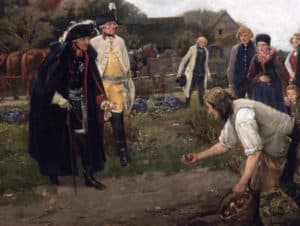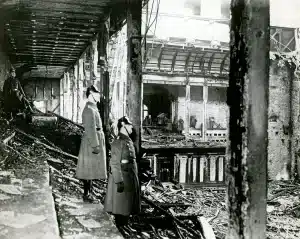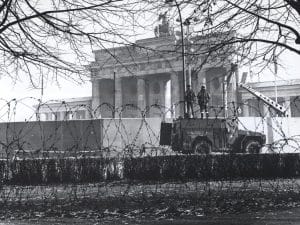“Some people are larger than life. Hitler is larger than death.”
Don Delillo, author of White Noise
Without a doubt one of the most pervasive, and persistent, conspiracy theories to have come out of the Second World War is that Nazi leader, Adolf Hitler, escaped to Argentina in 1945 – somehow evading capture, to live out the rest of his years in South American exile.
An incredible disappearing act, if true – perhaps the greatest magic trick of the 20th century – to some, the ultimate cold case.
Could there be some legitimacy to the tale? Contrary to the more conventionally held conclusion – agreed upon by the vast majority of historians – that Hitler spent his final days cloistered inside a concrete reinforced bunker, before perishing at his own hand alongside his wife, Eva, as Soviet troops descended on the Nazi capital.
It is not unusual to encounter this theory when the question of the brutal climax of the war in Europe – the ‘Battle for Berlin’ – is discussed. I have happened upon it myself thousands of times, and with frightening regularity also encountered people who are willing to believe that there may be some accuracy to the myth.
No doubt many may truly consider it possible. Some of those who reference it undoubtedly also view it as simply fodder for a cheap laugh. Providing the same kind of mediocre satisfaction as school yard gossip.
Perhaps the ability of the story of Hitler’s escape to penetrate mainstream consciousness lies in its seeming inoffensiveness. Unlike greater, and more threatening, contrivances, the victims of this story are none.
Not so can we say for Holocaust denial.
Suggestions of Hitler’s intrepid escape can elucidate a sly chuckle and inside joke glance, while remaining satisfyingly provocative and obtuse.

What we can say then before venturing deep into the detective work is this: If Hitler did abscond with his newly minted wife in tow, his flight did not lead to an extension of the war. It did not lead to further bloodshed or the rise of the 4th Reich. It did not facilitate further genocide and planetary misfortune.
It would be a titillating coda to a furious and un-accommodating conflict.
The ‘official’ version of events understandably does little to address the dissatisfaction inherent in such an unceremonious ending. An escape from justice. And an escape from retribution at the hands of the victims.
But a very real escape into anonymity? Could it be possible?
While this alternate story has become somewhat of a dog toy among amateur historians, is it fair to portray it as mere supermarket rag sensationalism? The deluded fan fiction fantasies of a minority group of conspiracy theorists? Pulp chicanery presented as deep-dive investigative journalism? Or is there some greater force at work?
Beyond the fringe group of advocates, responsible for propagating the story through various forms of media, are there – or were there – other parties that have, and would have, benefitted from the proliferation of this story?
And the smoke and mirrors of a concocted and intentionally misleading tale.
Where did the radical idea of Hitler’s escape come from, and when did it become something that could be seriously considered?
For that matter, what evidence is there of Adolf Hitler’s final days in Berlin and what exists to be studied of his physical remains?
Perhaps best when asking these questions to start from the beginning – or the end.
–

An Iron Curtain Descends - The British Search For Answers
“The average person has the most fear of death and in reality thinks most rarely about it. The most prominent one occupies himself with it most persistently, but nevertheless fears it the least. The one lives blindly day to day, sinning away, only to sink down before the grim reaper. The other carefully observes his approach but then looks him in the eye, calm and composed.”
Adolf Hitler. Hitler’s Second Book: The Unpublished Sequel to Mein Kampf
Tasked in 1945 with investigating the fate of Adolf Hitler, British counter-intelligence officer Hugh Trevor Roper arrived in Berlin to confront uncertainty on the ground, and apparent Soviet ineptitude when faced with marshalling the facts. Despite being in the best position to illuminate the situation, the Soviets appeared reticent or reluctant – or both.
It would seem in September 1945, that the most wanted man in the world had simply disappeared. Whereabouts unknown. Although much speculated.
Killed in fighting in Berlin? Murdered by officers in the Tiergarten? Possibly hiding out in South America, Franco’s Spain, or with bandits in mountainous Albania?
Hitler’s death had been officially announced by Supreme Commander of the Navy, Admiral Karl Dönitz – the Nazi leader’s designated successor – on May 1st 1945.
Simply stated, the Führer had ‘died fighting at the head of his troops in Berlin’. But was it true?
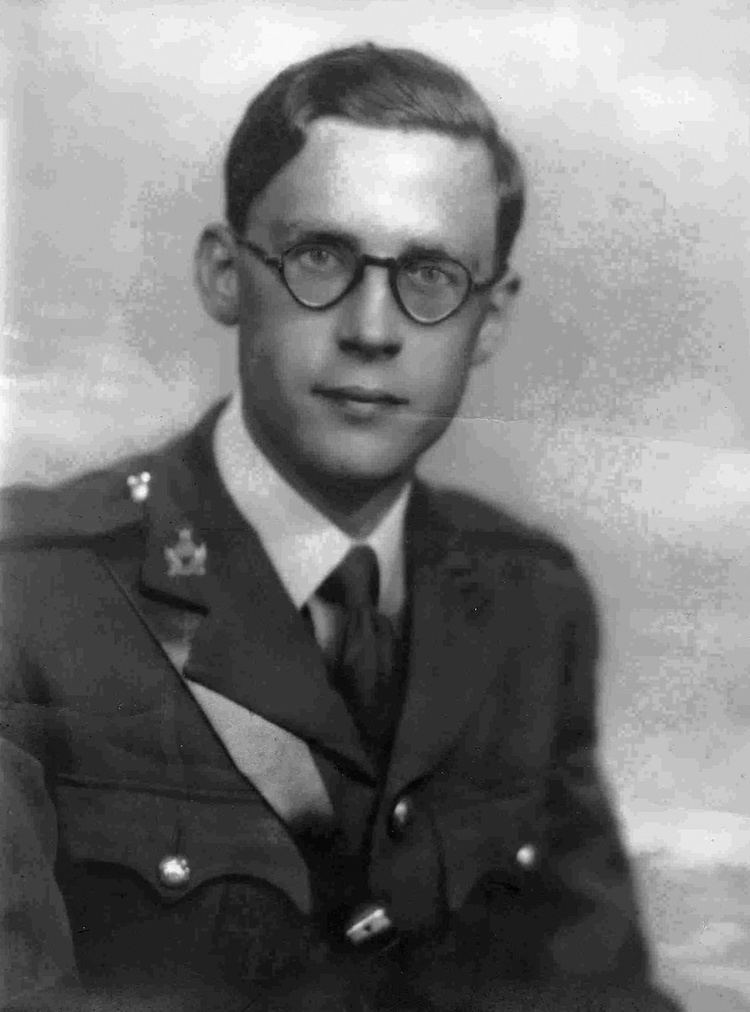
The report Trevor Roper compiled, published as ‘The Last Days of Adolf Hitler’ remains required reading and an essential starting point for anyone intrigued by the circumstances regarding the Nazi leader’s demise. Most remarkable for the factual reassessments presented as forewords, annexes, and appendices, as Trevor Roper worked on no fewer than six editions – in his own words: “according to the opportunities of knowledge, and the resources of vocabulary”.
Part detective mystery, part political exorcism – Trevor Roper, operating under the alias of “Major Oughton”, was led to confront not only the open case of Hitler’s fate but also the consequences of Soviet control in Berlin, specifically the site of the Führerbunker, and the stony faced response received from Soviet authorities whenever enquiries were made.
Not only at this time did the Soviets forces:
- possess a formal statement of Hitler’s death (following an attempt by Wehrmacht General Hans Krebs to arrange a temporary local surrender with the Red Army on April 30th, thirteen hours after Hitler’s suicide)
- But had taken complete control of the crime scene two days later, undertaking an investigation led by SMERSH counter-intelligence officers to retrieve what were believed to be the remains of Adolf Hitler and Eva Braun
- And even captured – and identified – key members of Hitler’s entourage by May 4th, who could provide eyewitness testimony to the Nazi leaders fate.
These facts appeared concealed from the British agent in a thick ideological fog.
Although, before Trevor Roper’s arrival in the city, the Soviet authorities had announced that Hitler was indeed dead. They would subsequently renege. Before admitting that the corpses of Hitler and wife Eva had indeed been identified. Shortly followed by accusations that Eva Hitler was hiding in the British sector of occupied Germany.
Why then were the Soviets so intent on obfuscating the matter? Placing an Iron Curtain around any attempt to ascertain the truth.
Trevor Roper would conclude that alongside Cold War tensions, this approach may have had more to do with the Soviet modus operandi than the facts on the ground, stating:
“Previous tyrannies of the spirit have sought to crush defeated but dangerous philosophies by emphatic, public executions: the gibbet, the block, the bloody quarters exhibited in terrorem populi. But such spectacular liquidations, however effective at the time, have a habit of breeding later myths: there are relics of the dead, pilgrimages to the place of execution. The Russian Bolsheviks have therefore preferred in general a less emphatic method: their ideological enemies have slid into oblivion in nameless graves at uncertain dates and no relics of them are available for later veneration.”
Perhaps then it was a matter of keeping Hitler immune from discovery. And his legacy shrouded in confounding mystery.
In June 1945 – before the start of Trevor Roper’s assignment – Soviet Marshal Zhukov and Colonel-General Berzarin, had made public statements to the press on the last days in Hitler’s chancellery, with both doing little to address speculation of his death. Nothing of the Soviet investigations was mentioned, with both even going as far as speculating Hitler had fled – and was possibly hiding out in Spain.
Trevor Roper would point to this event as being cataclysmic in the dilemma of comprehending Hitler’s fate: “Total silence enveloped the ostentatiously unresolved mystery, and this apparent repudiation of past admissions led, more than any other cause, to the growing belief that Hitler was alive after all.”
Perhaps this was simply a choreographed theatrical display, the construction of which can be traced all the way back to Soviet leader Joseph Stalin. An attempt to throw a veil of silence over the issue at best and use it to spread distrust and suspicion among the victorious allies at worst.
In 1945, Spain was still ruled by Caudillo Frascisco Franco, who despite espousing neutrality during the Second World War, would remain aligned to the Axis powers. And considered by the Soviets, post-WWII as a belligerent nation assisted by the West and the United States.
In the words of Hugh Trevor Roper, it is possible, however, that the Soviet approach to the issue of Hitler’s fate – that he remained alive – was simply a matter of Stalinist orthodoxy, and the adequate response from the bureaucratic machinery of the dogmatic Soviet system.
The infallible Stalin had declared the truth, before which inconvenient evidence must bow and retire.
Regardless, the conclusion to the British counter intelligence officer’s report was eventually clear, and as final as it could possibly be, when presented on November 1st 1945.
Hitler had died by his own hand.
A stage managed end with a single bullet to the head from a Walther 7.65.
His body burnt, lest it should be identified and insulted, in a rudimentary funeral pyre of dirt and kerosene.
Trevor Roper would in a later revision – with the benefit of further information – write of the remains being discovered by the Soviet forces and identified by dental staff familiar with the intricacies of Hitler’s mouth. The bodies of both Adolf and wife Eva transported away to be stored in obscurity.
It would take until the 1968 for the Soviets to finally divulge that they had in-fact carried out detailed investigations in 1945 and 1946 – when they finally did pull back the Iron Curtain erected around the issue, they would focus on one important point of contention with Trevor Roper’s findings.
While the British historian turned Intelligence Officer would conclude – specifically following interviews with Hitler’s chauffeur, Erich Kempka, and Hitler Youth leader, Artur Axmann – that Hitler’s death was the result of a self inflicted gunshot wound.
The Soviets would propose something to the contrary – death by poison pill.
An act of cowardice.
Regardless of the deviations between these commonly held Western and Soviet perspectives, we can sufficiently refer to this sequence of events as the ‘official’ story. The facts and evidence to support this composed of an intricate web of eyewitness testimony, meticulous documentation – and forensic evidence – although we will get to that later.
First, let’s closer examine the timeline and minutiae of the case for suicide.
–

The Case For Suicide - The Doomed Despot
“Hitler reacted primarily in a sadistic fashion toward people, but masochistically toward fate, history, the “higher power” of nature.”
Erich Fromm, The Art of Loving
Emerging, if at all, from tortured buildings bearing evidence of the ravages of war, many Berliners in early 1945 were left living as if prehistoric cave dwellers. Subject to repeated aerial bombardment by the flying fleets of the British Bomber Command, and the United States Army Air Forces. Confronted by a regime violently contracting in its dying throes.
Yet, life went on with a lunatic normality.
Street vendors would defiantly sell flowers, factories embrace the throng of workers who would struggle through the broken city to reach them, and postmen deliver mail to what remained of the addresses in the doomed capital of the ‘Thousand Year Reich’.
At exactly 11:30am on April 20th 1945 – coinciding with Adolf Hitler’s 56th birthday and the timely end of British and American bombing of the Nazi capital – Berliners became deathly familiar with a sound until that time not heard in the beleagured city. Soviet artillery was finally in firing distance of the capital and had begun systematically and methodically pounding the streets and buildings.
Over the next eleven days, the unimaginable ferocity of the bombardment of the city by Soviet artillery would outweigh the total tonnage of ordnance dropped on Berlin by the Western allies for the previous five years.
Hitler’s earlier arrival in the city on January 16th 1945 had been the result of the rapid advances made by the Soviet army on the eastern front. With the Nazi leader’s personal train arriving at Platform 17 of the Berlin Grünewald station for the last time before he would be transported to the New Reich Chancellery in a limosine – turning his gaze away from the already ravaged capital. From this office on Wilhelmstrasse, Hitler would attempt to conduct the final stages of the war in Europe, until a US air attack on Berlin on February 3rd 1945 forced his permanent relocation to the underground Führerbunker in the Chancellery garden.
Completed in 1944, this subterranean refuge had evolved from a small improvised air raid shelter (the Vorbunker), constructed beneath the Old Reich Chancellery building in 1936, to include a further, larger, space (known as the Führerbunker), located around 8.5 metres beneath the Chancellery gardens. Construction firm Hochtief – also responsible for Hitler’s Bavarian Alpine retreat, the Berghof, and the Wolf’s Lair headquarters in Rastenburg – would oversee the completion of both quarters.
It was from the Führerbunker that Hitler would issue the so-called ‘Nero Decree’ (the Demolitions on Reich Territory Decree or Befehl betreffend Zerstörungsmaßnahmen im Reichsgebiet) in March 1945 – specifying that, due to the advances of the Soviets, military and civil authorities should destroy anything of value on German soil rather than surrender it to the enemy. The same month on March 9th, Operation Clausewitz – the codename for the establishment of defensive fortifications in Berlin – would be initiated, stipulating that: “The Reich capital will be defended to the last man and to the last bullet.”
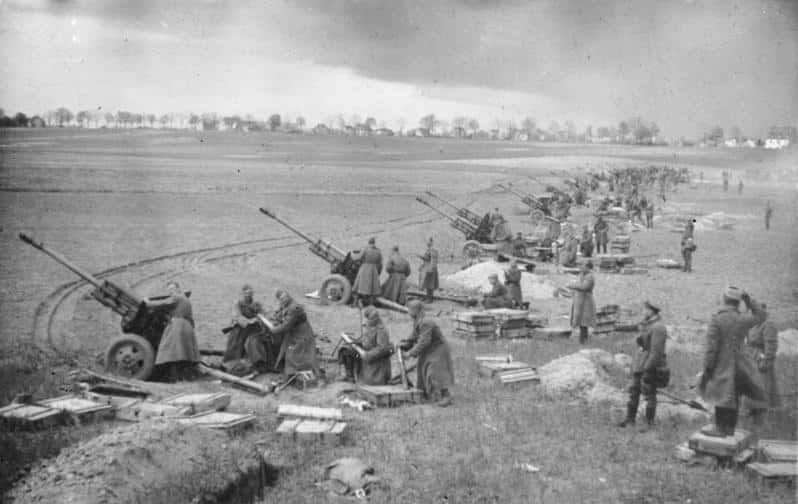
On April 16th 1945, the Battle of Berlin would finally begin – with Soviet troops pushing to advance across the Oder river; the 1st Belorussian front breaking through the Seelow Heights three days later while the 1st Ukrainian front pushed through Forst, south of Berlin.
By April 24th 1945 elements of these two fronts had completed the encirclement of the city.
Fighting now would be more personal, and house-to-house, with the over two million Soviets bearing down on Berlin’s exhausted occupants. One hundred and twenty of the capital’s 248 bridges would be intentionally blown, as SS men sought to establish a defensive perimeter (Zone Z) around Hitler’s Führerbunker. While Volksstürm men would make a desperate last stand near the Olympic Stadium with Italian ammunition for their German rifles. A detachment of French foreign legion SS troops would be stationed in the vicinity of the Reichkanlei and Reichstag – the last defenders in the heart of the Nazi government quarter.
The chimera of ghost armies and relief units would echo in Hitler’s autocratic ravings – but they would not appear on the field. Nor could the Luftwaffe – once the pride of the Nazi war machine – any longer command the skies.
Hitler’s capital braced to be crushed under the might of Soviet tanks and infantry, while the leader himself unwound in his underground lair.
According to eyewitness accounts of the time in the fated bunker – collected and reiterated by countless historians – Hitler’s final days in Berlin were defined by oscillating episodes of crippling paranoia and defeatism, jubilant optimism, and vocal accusations of treachery and betrayal.
The Führer’s leadership was crumbling to the sound of Soviet artillery and uncontrollable fits of rage.
His physical condition similarly deteriorating rapidly, and his intentions of dying by his own hand rather than being captured by the Soviets became crystal clear. For the Austrian corporal turned leader of one of the most pernicious and destructive regimes in human history, the tragic scenery of his own personal Götterdämmerung (Twilight of the Gods) had carefully shifted into place.
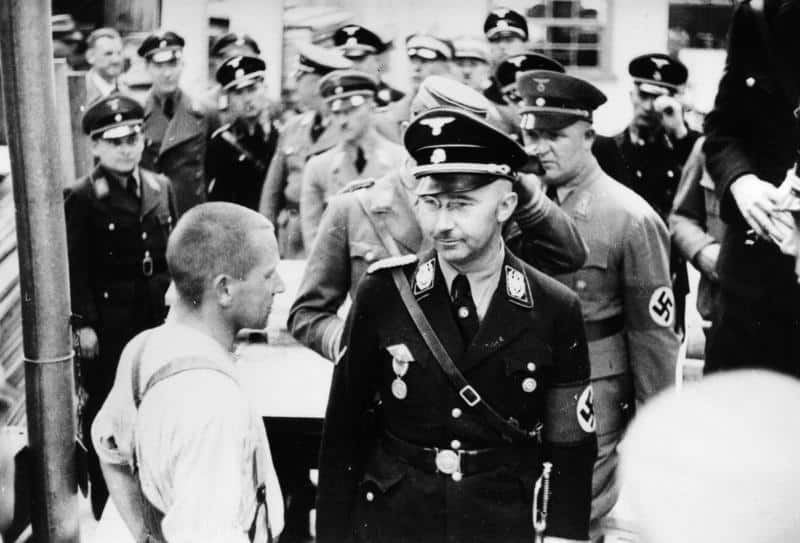
Two events are widely considered to have bookmarked this final stage in the ‘official timeline’ of Hitler’s life, the penultimate chapter leading up to his suicide. On April 28th, Hitler was confronted with the news that his trusted right hand man, Heinrich Himmler – head of the SS – had been involved in surrender talks with the Western Allies. By the end of the following day, the Führer would also learn that erstwhile ally, Benito Mussolini, had been captured by partisans, executed, and hung up by his heels in public.
Two of his closest allies turned – one traitor and the other a cadaver.
Understanding the detailed timeline of events between these two revelations is essential in comprehending what happened next – and what truth there may be to the proposal of Hitler’s escape:

Führerbunker Timeline (April 28th-May 5th)
April 28th: According to Hitler’s bodyguard, SS Colonel Otto Günsche, after Hitler heard of Himmler’s betrayal his liaison officer, Hermann Fegelein, was immediately suspected of complicity in the plot. Arrested and subject to court martial, he was shot on the night of April 28th/29th. Despite Fegelein being married to Eva Braun’s sister, Hitler did not object or intervene to issue a pardon. Rochus Misch, telephone operator in the Führerbunker, would later describe how: “A Reichssicherheitsdienst colleague shot Fegelein from behind with a machine pistol in the cellar corridor”.
April 28th – Midnight: Gertrude Junge, Hitler’s secretary, would describe the atmosphere in the bunker at the end of April as having taken on “an aimless, dreamlike quality”. Noting that Hitler had finished dictating his personal and political testament within the first hour of April 29th.
April 29th – 1am: Hitler marries his long term companion, Eva Braun in a ceremony that lasts only ten minutes, and is carried out in the presence of Propaganda Minister Goebbels and Head of the Nazi Party Chancellery Bormann. There are no female witnesses. Hitler then returns to impatiently oversee Junge transcribing her shorthand notes of his personal and political wills that he dictated at the end of the night before.
Describing his grim intentions for married life, Hitler would announce: “I myself and my wife – in order to escape the disgrace of deposition or capitulation – choose death. It is our wish to be burnt immediately on the spot where I have carried out the greatest part of my daily work in the course of twelve years’ service to my people.”
According to Junge she was then asked by Hitler to take note of his final political testament. In it he decries that he never intended to be faced with war in 1939, blaming Jewish interests for the subsequent carnage. Closing the first part of his political testament, Hitler again outlined his intention to end his life, saying: “I have therefore decided to stay in Berlin and there to choose death voluntarily when I determine that the position of the Führer and the Chancellery itself can no longer be maintained.”
April 29th – 4am: Hitler’s political testament is signed by four witnesses – Goebbels, Bormann, and Generals Burgdorf and Krebs – and distributed to three messengers. One copy to be sent to Admiral Dönitz (now designated acting Reichspresident), one to Marshal Schörner, head of Army Group Centre, and the other to the headquarters of the Nazi party in Munich.
April 29th – 5am: Hitler retires to his quarters with his new wife, as Traudl Junge is left to finish typing Joseph Goebbels’ testament. Goebbels’ and his wife Magda will conspire to murder their six children before committing suicide on May 1st. Junge would later say of the children: “they knew nothing of the fate awaiting them, and the adults did all they could to keep them unaware of it.”
April 29th – 10am: A Hitler Youth runner appears at the upper bunker of the New Reich Chancellery to report that Soviet tanks are now only 500m from the building. Thirty minutes later, the air balloon supporting radio-telephone communications between the bunker and army headquarters is shot down. All telephone communication between the bunker and the outside world have ended.
April 29th – 11am: Hitler’s valet, Heinz Linge, knocks on the door of his bedroom – for the previous six years it had been Linge’s job to time Hitler as he got dressed, but this time he is sitting on the bed fully dressed, except his tie. Hitler’s barber, August Wollenhaupt, then appears to attend to his hair and moustache, and Hitler receives cocaine eye drops, administered to his right eye by Linge, and takes a packet of anti-gas pastilles to suck on during the day (made of strychnine and atropine).
April 29th – 2pm: Hitler takes a meal with Eva Braun and a group of secretaries. Since the start of the battle of Stalingrad, the Nazi leader has always prefered female company during his meals. Easier to avoid difficult issues entering into the conversation. Traudl Junge notes that this time Hitler chooses to matter-of-factly explain the ‘best method of suicide’ – to shoot yourself. To which Eva reacts by explaining that she prefers cyanide, saying: “I want to be a beautiful corpse.”
April 29th – 3pm: One of the Reich Chancellery doctors, Werner Haase, is tasked with testing the cyanide on Hitler’s dog, Blondi, by crushing a capsule inside the dog’s mouth with a pair of pliers. To which Blondi falls sideways “as if struck by lightning”. Telephone operator Rochus Misch would note the smell of bitter almonds and have to rush from his position to the cellar of the new Reich Chancellery to escape it.
April 29th – 10pm: Hitler receives the news of Mussolini’s death from a transcript of a radio broadcast reportedly accidently picked up by an orderly who was trying to tune a shortwave radio. His valet, Heinz Linge notes that Hitler reads the text and underlines three words referencing Mussolini’s condition: ‘hanging upside down’
April 30th – 2am: Hitler, having summoned guards and servants for a final farewell, greets SS doctor Professor Ernst Schenck, who remarks on the Führer’s distant stare: “(his eyes are) like wet pale blue porcelain, glazed actually more grey than blue… filmy like the soft skin of a soft rice grape.” Leaving the meeting, Schenck encounters Frau Hitler with a party of drinkers, sitting at the table “like a Rhineland carnival queen.”
April 30th – 4:30am: Hitler retires to bed
April 30th – 6:30am: Valet, Heinz Linge, discovers Hitler awake, already fully dressed and lying on his bed.
April 30th – 7am: Eva Hitler decides to visit the garden above the Führerbunker to see the sun once more. As the sky is darkened with smoke from the nearby battle to take the Reichstag, she only remains briefly before returning to her quarters. Thirty minutes later, Hitler follows Eva’s example and ascends the steps of the bunker towards the Chancellery garden. As he approaches the door, shelling begins outside, and he instead turns around and returns to his quarters.
April 30th – 12:30pm: Eva Hitler is in her room choosing her final outfit, as Hitler summons Reichsleiter Bormann to come to his study, where he explains that he will take his life with ‘Fraulein Braun’ (Hitler would never refer to her as Frau Hitler) and has instructed his bodyguard Günsche to cremate the bodies. Bormann had earlier made every attempt to persuade Hitler to escape to Obersalzberg, but in vain.
April 30th – 12:45pm: Hitler summons Günsche and tells him that the time has come and that his chauffeur, Erich Kempka, should bring the petrol to burn the bodies immediately.
April 30th – 1pm: Hitler eats his final meal – prepared by his personal chef, Constanze Manziarly. A dish of spaghetti with a cabbage and raisin salad.
April 30th – 1:30pm: Switchboard operator Rochus Misch gets up to stretch his legs by visiting the New Reich Chancellery and encounters three men in uniform. Two high ranking SS officers and a third – Gestapo chief, Heinrich Müller.
April 30th – 2:45pm: The staff members are gathered in the Führerbunker corridor to say goodbye to Adolf and Eva. Among them, Martin Bormann, Joseph and Magda Goebbels, and Hitler’s secretaries. Traudl Junge would later comment that upon shaking Hitler’s right hand she realised he was looking right through her.
April 30th – 3:30pm: Otto Günsche stands guard outside Hitler’s office, as the Nazi leader commits suicide alongside Eva. Also waiting outside are Goebbels, Bormann, and some other staff. Traudl Junge is in the upper bunker corridor when she hears the sound of a gunshot, to which Helmuth Goebbels’ loudly exclaims: “Bullseye!”.
“Bormann went in first. Then I followed the valet Linge. Hitler was sitting in a chair. Eva was lying on the couch. She had taken off her shoes and placed them neatly together at one end of the couch. Hitler’s face was covered in blood. There were two guns. One was a Walther PPK. It was Hitler’s. The other was a smaller pistol he always carried in his pocket. Eva wore a blue dress with white collar and cuffs. Her eyes were wide open. There was a stench of cyanide. The smell was so strong that I thought my clothes would smell for days – but this may have been my imagination.”
SS Colonel Otto Günsche, Hitler’s bodyguard
Three SS guards and valet Heinz Linge then carry Hitler’s body to the Chancellery garden, as Martin Bormann lifts the body of Eva Hitler, covered in a blanket out into the corridor where Erich Kempka carries her to the stairs before Günsche takes over. Chauffeur Kempka then arrives with petrol, the bodies are placed in a shallow depression outside the bunker, near an abandoned cement mixer. Joseph Goebbels’ produces a box of matches, whereup Linge lights some paper to create a torch and sets fire to the bodies. As the funeral party returns to the safety of the staircase, a final Heil Hitler is shouted, arms raised, before they descend again into the underground purgatory of the bunker.
“(Even after the bodies were burned), we were imprisoned by the very presence of Hitler again. We could not get away from it (the smell). It smelled like burning bacon.”
Erich Kempka, Hitler’s chauffeur.
April 30th – 4:15pm: Otto Günsche sits down next to Traudl Junge, grabs a bottle of schnapps from her hand and says: “I have carried out the Führer’s last order. His body has been burned.” Heinz Linge, Hitler’s valet, orders the blood stained rug in Hitler’s quarters to be taken to the surface and burned.
April 30th – 6:30pm: Two Waffen SS officers (Ewald Lindloff and Hans Reisser) manage to partially cover up the shallow bomb crater full of remains with dirt. It has been more than 2 hours since the bodies were brought to the surface, and the SS men have had to return to the remains with more petrol at least once to reignite the fire and complete the job. Subsequent interrogations would suggest around 200 litres of petrol was used.
May 1st – Evening: Joseph and Magda Goebbels arrange the deaths of their six children in the bunker before committing suicide.
May 2nd – 08:23am: General Helmuth Weidling, commander of the Berlin Defence Area, is taken to see Red Army General Vasily Chuikov and orders that the city’s remaining defenders should surrender.
May 4th 1945: Hitler’s remains are discovered by Red Army troops in the garden of the New Reich Chancellery
–

The Grey Wolf - Hitler’s Escape To Patagonia?
“Hitler at this stage could undoubtedly have written one of the most comprehensive travel guides of the 20th century… But, of course, all available evidence suggests that such rumors were nonsense.”
Luke Daly-Groves, author of Hitler’s Death: The Case Against Conspiracy
Perhaps what stands out most about the ‘unofficial’ version of Hitler’s final years, is not how fantastical the claims may appear, but that the details and fates of the assorted characters differ so greatly from the ‘official’ version.
Various alternate timelines have been proposed since 1945, some more comprehensive than others. With a string of otherwise unknown authors stepping up to the plate to swing at one of the greatest mysteries of the 20th century: among them Ladislao Szabo, a journalist from Buenos Aires and author of ‘Hitler Lives’, Jeff Kristenssen, author of ‘Hitler Died In Argentina: Operation Patagonia’, and Patrick S. Burnside, author of ‘The Escape of Hitler’.
It is noteworthy, perhaps, that those three books are available almost exclusively in Spanish.
Most recently in 2011, the work ‘Grey Wolf: The Escape of Adolf Hitler’ was published and received international attention, challenging conventional understanding of the Nazi leader’s fate.
The combined work of two authors, Simon Dunstan and Gerrard Williams, the book details the dramatic exploits of an extensive cast of characters in ensuring Hitler’s escape and safekeeping. And stands in complete contrast to the narrative commonly agreed upon by almost all other experts in the field.
A compendium of exceptional claims seamlessly stitched together with more conventionally agreed-upon events.

Dunstan and William’s timeline sees Hitler with Reichsleiter Bormann, Gestapo-chief Heinrich Müller, and Hitler’s brother-in-law Fegelein, residing in a Patagonian paradise reminiscent of southern Germany and the Bavarian mountains. Peacefully retired in the Argentinian town of San Carlos de Bariloche, mere statistics among the millions of other Germans who would come to call the South American country home.
Eva Hitler playing a starring role, shooting Rolleiflex as court photographer while entertaining her daughters – who had been shipped to Argentina in the 1930s. Hitler relaxing in peaceful exile until dying of natural causes in February 1962.
While the first half of the book provides a meandering retelling of the situation up to 1945, the most important deviation in Dunstan and William’s story from the official timeline would come quite late; as by sleight of hand, two body doubles are introduced on April 28th to the proceedings. One named Gustav Weber who resembles Hitler, and the other, an actress from Propaganda Minister Goebbels’ stable with makeup applied so as to look like Eva Braun. Carefully choreographed by Hitler’s close accomplice – head of the Party Chancellery and personal secretary to the Führer – Martin Bormann, the authors suggest this charade was maintained for two days before the doubles were murdered, almost certainly by Gestapo chief Heinrich Müller. Ensuring that the real Hitlers could escape undetected and remain off the radar.
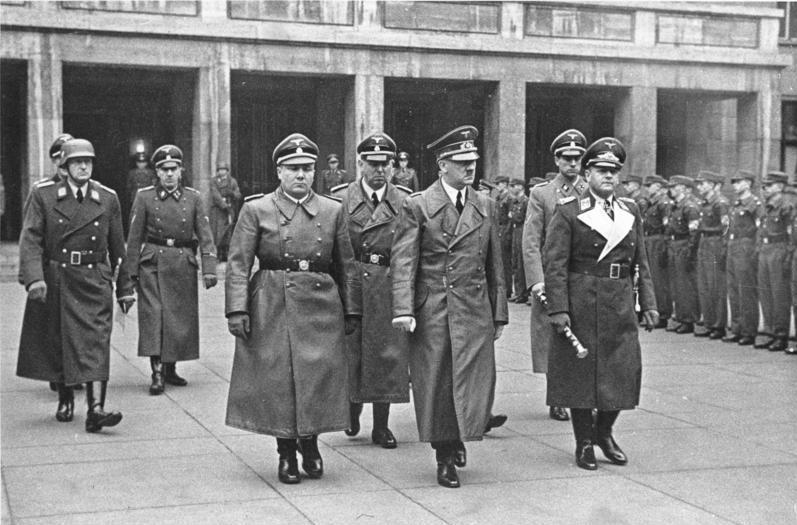
According to the authors, Hitler’s passage from Berlin to Argentina would take him via Spain (where he would arrive on April 29th at the military base at Reus) before being flown to the island of Fuerteventura to embark on a submarine voyage, covering 5,300 miles, to the Argentinian coast.
A great escape that would be facilitated by vast sums of capital that Bormann had amassed in Hitler’s name, shuffled off to Argentina following the loss of Stalingrad in 1943 by the Führer’s doting servant. A spider’s web of intrigue involving money laundering Swiss banks, SS slush funds, looted gold bullion and the machinations of supposedly neutral countries
The plan – which the authors’ name as Aktion Feuerland – would though, inevitably, be predicated on the connivance of the Western Allies, bargaining for technology and cash.
More nefarious than that in-fact, the explanation from Grey Wolf author, Gerrard Williams: that a shadow government in the United States, comprised of the military industrial complex and its representatives, colluded with head Nazis to enable Hitler’s escape in exchange for technical support and scientific research that would help in the coming reckoning with the Soviet Union.
Of all the different alternative iterations of the final Hitler timeline, that presented in Grey Wolf can be considered the most complete. It is nothing less than a tour de force of the various extraordinary narratives put forth since 1945.
But with great claims comes the need for great evidence.
And it is here that the story proves lacking.
Like with Trevor Roper and the many mainstream historians who followed him, the authors of Grey Wolf try to rely on eyewitness accounts, while exposing cracks in the conventionally accepted truth. Although here these witnesses make for a curious cast. From a man who is presented as Croatian dictator Ante Pavelic’s carpenter to the housemaid of a home Hitler is said to have visited in 1949. A German sailor who had survived the scuttling of the Graf Spee battleship, and a pair of Argentine socialites known for their enthusiastic support for Nazism.
Unlike the characters involved in the ‘official’ story, these were not subject to British or American interrogations – and certainly have not seen their allegations withstand Soviet torture.
The list of sources in Grey Wolf is extensive and includes reference to declassified FBI files and many of the mainstream texts on the subject, as well as newspaper articles and obscure archives. And one thing is certain, Grey Wolf is not lacking in depth. Almost each phrase is justified in an additional appendix, and to the layman unfamiliar with academic padding, it may appear to be legitimated by its mere density.
Bludgeoning the reader with intriguing anecdotes, facts and figures is no new technique.
Some of the periphery details presented in Grey Wolf are particularly noteworthy, and feature in the first half of the book – before the story of Hitler’s escape becomes clear:
- That Propaganda Minister, Joseph Goebbels, was responsible in April 1945 for trying to persuade Hitler that it was their “duty to die among the ruins of Berlin” – p138
- That Martin Bormann conspired to oust both Hermann Göring and Heinrich Himmler in the late days of April 1945 – p138
- That Gen Robert Ritter von Greim was unable to fly to Plon and arrest Himmler for treason – despite leaving with Hanna Reitsch on April 29th by all contemporary accounts – p139
- That Evita Peron, wife of Argentine leader Juan Peron, had financed much of her philanthropic work using money taken from Martin Bormann. – p283

Not only is it proposed that Hitler escaped to Argentina but he was also accompanied by three men whose whereabouts can also be traced rather conclusively – and when removed from the story provide a substantial obstacle. Reichsleiter Martin Bormann, Gestapo chief Heinrich Müller, and Hitler’s brother in law, Hermann Fegelein.
By all other contemporary accounts, Bormann died trying to escape Berlin in 1945 (in the vicinity of the current central train station), while Müller is suspected to have similarly fallen in fighting. Only to be buried in the Jewish Cemetery on Auguststrasse. Many accounts have clearly detailed how Hermann Fegelein was executed after being suspected of collaboration with his superior, Heinrich Himmler, and his attempts to negotiate a surrender on the western front.
To think that in the twilight hour of Berlin’s days under Nazi rule, that the leadership could execute an audacious escape – conning everyone else in the Führerbunker into thinking that not just Hitler and Eva, but also these three characters had escaped their much overdue ends – is absurd. Not only positing that the Führerbunker witnesses were unable to recognise Döppelgangers but continued for years afterwards to maintain the ‘official version’ of events. Either in ignorance or collusion.
Like Hugh Trevor Roper’s study in 1945, however, Grey Wolf shares one important characteristic – its complete lack of physical evidence to reach conclusions.
The British intelligence officer’s report in November 1945 would begin with the following statement:
“The only conclusive evidence that Hitler is dead would be in the discovery, and certain identification, of the body. In the absence of this evidence, the only positive evidence consists in the circumstantial accounts of certain witnesses who were either familiar with his intentions or eye-witnesses of his fate.”
Pointing to a rudimentary test carried out in 2009 on fragments of what have always been assumed to be Hitler’s skull retrieved by the Soviets, the authors of Grey Wolf note that ‘no concrete forensic evidence’ exists – as of 2011. A misunderstanding at best.
It would, however, take until 2017 for a further study to introduce a final – and most conclusive – piece to the Hitler puzzle.
–

Eyes On The Forensic Evidence - Operation Myth and Operation Archive
“Stalin was keen – just like his successor in the Kremlin today – to sow division and discord in the West by suggesting that the British or Americans were sheltering Hitler.”
British historian Guy Walters, author of Hunting Evil
Eyewitness accounts – especially recollections of chaotic and stressful events – should always be treated with suspicion. Similarly, a paper trail of documents – regardless of the authority stamped on the letterhead – can always combust when exposed to the right amount of sunlight.
While Hugh Trevor Roper’s work remains essential reading on the subject of Hitler’s demise, it has been criticised for its use of limited first hand accounts:
The Oxford educated historian initially had access to only a small number of witnesses in British and American custody when compiling his first report:
- Erich Kempka, Hitler’s chauffeur
- Else Krüger, Party Secretary Martin Bormann’s secretary.
- Later, he would add Hitler secretary Gerda Christian and Hitler Youth leader Artur Axmann to that list.

The main Nazi party officials involved in the execution of Hitler’s last wishes and the disposal of his body – Joseph Goebbels, Martin Bormann, and Hitler’s surgen Ludwig Stumpfegger – were either thought to be dead or reported missing.
The most important remaining witnesses, and participants, from Hitler’s inner circle of attendees, were in Soviet custody – only to be released much later and unavailable in the West to corroborate accounts of Hitler’s fate. These included:
- Otto Günsche, Hitler’s personal SS adjutant
- Heinz Linge, Hitler’s person valet
- Hans Baur, Hitler’s personal pilot
- Rochus Misch, the Führerbunker telephone/radio operator
- Wilhelm Mohnke, Waffen-SS general
- Dr. Ernst-Günther Schenck, physician and operator of a casualty station in the Reich Chancellery
- Johannes Hentschel, mechanic in charge of the bunker’s electricity and water supply and last remaining survivor to be discovered in the bunker in May 1945.

If we are to attribute any veracity to the claims made by each of these characters, the conditions of their treatment must be considered.
Despite systematic torture of this group in the Soviet dungeons of the Lubyanka and Butyrka at the hands of NKVD interrogators – and the prying ears of cell informants charged with milking every last detail from the group – nothing of Hitler’s plan to escape to Argentina was mentioned. Nor had the initial – more innocent – investigations of SMERSH in May/June 1945 unearth a smoking gun.
Certainly of the main trio targeted by the Soviets – Günsche, Baur, and Linge – the latter two, with their lack of military training or preparation for interrogation, would surely have broken under the strain and spilled anything and everything. Yet, despite the pressure, even in their wildest stages of submission, they did not have the wherewithal to propose anything so drastic to alleviate their suffering.
To all intents and purposes, it would appear from the collated eyewitness Führerbunker accounts that Hitler had perished at his own hand. The disagreement would be in the details. Was it by bullet or by poison? And at what hour?
In 2016 and 2017, an investigative team composed of French journalist, Jean-Christoph Brisard, and Russian translator and filmmaker, Lana Parshina, were granted access to both the archives of the Russian state (GARF) and the Russian FSB intelligence service archives. In the process, offered the rare opportunity to consult the interrogation reports gathered by SMERSH and the NKVD of Hitler’s entourage – but more importantly the human remains considered to be those of Adolf Hitler.
Brisard and Parshina would also be accompanied by French forensic examiner and archaeo-anthropologist Phillippe Charlier – the so-called “Indiana Jones of the graveyards”, previously responsible for pronouncing on the remains of Richard the Lionheart, Joan of Arc, and Tribune of the French revolution, Robespierre.
This unprecedented access to both the fragment of skull stored in the GARF archive and the rows of teeth kept by the FSB would present some interesting conclusions.
In 2009, Connecticut archeologist, Nick Bellantoni had been granted access to the skull section (the rear left side) and determined that it was from someone aged between twenty and forty, and thus could not be Hitler’s. Phillippe Charlier would find fault with his American colleague’s verdict.
Bellantoni’s basis for his conclusion was a rudimentary examination of the structure of the bones – claiming the skull too fine and too fragile to correspond to that of an adult male. Additionally, the sutures that hold the plates of the skull together were said to be too closed – contrary to those of someone Hitler’s age who would have been wide open.
Charlier instead would state: “On a skeleton, the diagnosis of sex is performed only on the pelvis. It’s unthinkable with a skull, a mandible, or a femur. And you would need to have the whole skull. Which is not really the case here.”
Speaking about the sutures: “I wouldn’t risk giving an age to a bone like this based only on the gap in the sutures. They vary so much between one individual and another. It’s possible that my sutures are completely closed like those of an old person, while my grandmother’s were open when she died. I insist you can’t give the age of this skull on the basis of the sutures.”
On further examination, Charlier would find that the skull section shows signs of being buried – at least briefly – and that it bears marks that can only be ascribed to carbonisation from burning.
The skull also displays an exit wound from a gunshot – around 6mm wide. A bullet fired – Charlier concludes – at “cool, damp bone” – which would indicate impact either when Hitler was alive or shortly after his death.
In the GARF collection, the team were also allowed to examine a piece of sofa – said to have come from Hitler’s bunker – and discovered blood traces that corresponded to photos taken in 1946. “All of these traces can also be found identically in the photographs from 1946,” Charlier would say. “It would demonstrate astonishing counterfeiting skill if it was a copy.”
Blood tests carried out by the Soviets could only conclude that the blood type on the sofa matched Hitler’s – Type A (the type given in testimony from Hitler’s personal doctor, Dr Morell).
An interesting detail unearthed in the detective work of the team would provide insight into how the competing branches of the Soviet state dealt with the Hitler question in 1945 and 1946. The first investigation carried out by SMERSH counter-intelligence officers, followed by a further fact-finding mission in 1946 from the Ministry of the Internal Affairs (MVD) – codenamed ‘Operation Myth’.
Brisard and Parshina would have access to a wealth of Soviet era documents detailing how the initial investigation in 1945 gathered the bodies of Adolf and Eva, Joseph and Magda Goebbels (and their children), and General Krebs, the head of the German Army General Staff.
The section of the skull preserved in the GARF archives would only be discovered one year later in May 1946, as the second team – organised by the Ministry of Internal Affairs – was sent to conclusively confirm Hitler’s death, discovering remains the first team had overlooked in the process.
The bodies discovered by the SMERSH team were subsequently destroyed in the 1970s – following orders from future Soviet leader Yuri Andropov, then President of the Committee of State Security in the Council of Ministers of the USSR. This operation – codenamed Archive – would see the remains gathered from a plot in Magdeburg, in the military town on Westendstrasse, near house number 36 (now Klausenerstrasse), where they had been temporarily buried.
On April 5th 1970, a Top Secret document would record their destruction – stating the bodies were incinerated “by means of their combustion on a pyre on waste ground near the town of Schönebeck, eleven kilometres from Magdeburg. The remains were burnt, crushed to ashes with coal, collected and thrown into the River Biderin, which is confirmed by the present act. Signed Head of the Special KGB Unit u.m No. 92626.”
One part of Hitler’s body did avoid destruction, to be stored in the FSB (formerly KGB) archives. The team would also have access to the preserved sections of Hitler’s teeth to analyze.
Teeth that the Soviets had originally used to positively identify Hitler based on statements from his dentist’s assistant, Kathe Heusermann.

It was photos of these teeth – compared with three X Rays of Hitler’s skull taken in 1944 – that two Norwegian dentists had used to conclude, in 1972, that the material held by the Soviets matched. Working only from documents, Reidar Sognnaes (Dean of Harvard School of Dental Medicine) and Ferdinand Ström (a pioneer in forensic odontology), would contribute the first non-Soviet scientific report to lend credence to the theory of Hitler’s death.
This would, of course, do little to put an end to the conspiracy theories.
It would be mid-afternoon inside office number 344, third floor of the FSB’s Lubyanka archive in Moscow on July 12th 2017, that Jean-Christoph Brisard and Lana Parshina – along with forensic examiner Phillippe Charlier – would finally be granted access to consult the remnants of Hitler’s teeth.
Armed with a state of the art binocular microscope, Charlier reached the cold scientific conclusion of his study:
the teeth are authentic, not reproductions, time specific to the era, and definitively can be said to have belonged to Nazi leader, Adolf Hitler.
One final question remained to be resolved. Charlier consulted the teeth further to find traces of gunpowder, antimony, lead, or barium – the presence of which would indicate a gunshot through the mouth. While damage that could be attributed to fire was visible, Charlier noted something more curious – blue residue on some of Hitler’s original teeth.
Granted an even rarer look at three teeth attributed to Eva Braun – although impossible to identify when lacking dental records – the team found the same coloured traces. The shade of this blue, ironically, is known as Prussian Blue – named after a German chemist in Berlin in the early eighteenth century who discovered it. The indication itself is enough: Dark Blue – kuanos in Ancient Greek – is where the substance in question gets its name: Cyanide.
The most likely version of events involves both a bullet and a capsule of cyanide. The capsule is broken open by biting, then the contents are swallowed, as potassium cyanide isn’t deadly on its own – it has to react with stomach acids to become hydrogen cyanide. Thus allowing enough time for a personal coup de grâce. In Hitler’s case, a self inflicted shot from a pistol.
If the story were to end there, it would be remarkable enough already. Yet, when returning to Paris after the Moscow trip in 2017, Phillippe Charlier would find tiny pieces of tartar from Hitler’s teeth that had broken away during the examination and travelled westward with the latex gloves used during the investigation.
Analysis of these small fragments would find traces of vegetable fibre – but no meat (Hitler had been a vegetarian for several years before his death). More importantly a deeper analysis would find a lack of antimony, lead, and barium – Hitler had not shot himself in the mouth.
Modern forensics had concluded that which could not be laid conclusively to rest 75 years ago.
–

Conclusion
It is now evident that despite the obfuscation of Trevor Roper’s early work, the Soviets forces in Berlin in 1945 had actually carried out the necessary detective work to form a clear picture of what had happened to Hitler in his final days. And that those days ended conclusively in the Führerbunker. As agreed upon by the British and Soviets (although secretly) at the time.
With a bullet to the head, and most likely also a cyanide capsule in the mouth, contrary to any claim that Hitler may have escaped.
Addressing the hypothesis of the Nazi leaders escape, Trevor Roper would famously state: “the desire to invent legends and fairy tales … is (greater) than the love of truth”.
The last words on this subject, however, must certainly go to Jean-Christoph Brisard, head of the team that visited Moscow in 2016 and 2017, and author of the book ‘The Death of Hitler’:
“Science triumphs over all the witness statements taken together, over emotion, over attempts at manipulation.”
**
Verdict
NO – Hitler did not escape to Argentina in 1945.
***
Our Related Tours
To learn more about the history of Nazi Germany and life in Hitler’s Third Reich, have a look at our Capital Of Tyranny tours.
Think you already know enough about the rise and fall of the Third Reich? Take our Capital Of Tyranny Quiz and find out.
Sources
Beevor, Antony (2003), Berlin: The Downfall 1945, Penguin Books, ISBN 978-0-14-028696-0
Bullock, Alan (1962). Hitler: A Study in Tyranny. New York: Penguin Books.ISBN 978-0-14-013564-0.
Brisard, Jean-Christophe; Parshina, Lana (2018). The Death of Hitler. Da Capo Press. ISBN 978-0306922589.
Grayling, A.C (2006) Among the Dead Cities: Was the Allied Bombing of Civilians in WWII a Necessity or a Crime? ISBN 0-7475-7671-8
Kershaw, Ian (2001) [2000]. Hitler, 1936–1945: Nemesis. New York: W. W. Norton & Company. ISBN 0-393-04994-9.
Eberle, Henrik; Uhl, Matthias, eds. (2005). The Hitler Book: The Secret Dossier Prepared for Stalin from the Interrogations of Hitler’s Personal Aides. New York: Public Affairs. ISBN 978-1-58648-366-1.
Knopp, Guido (2003) Hitler’s Women. Routledge. ISBN 0-415-94730-8
Mayo, Jonathan (2016) Hitler’s Last Day: Minute by Minute , Emma Craigie | ISBN: 9781780722337
Moorhouse, Roger (2010) Berlin at War Routledge. ISBN: 9780465028559
Ryan, Cornelius (1966), The Last Battle, Simon & Schuster, ISBN 978-0-671-40640-0
Shirer, William L. The Rise and Fall of the Third Reich. ISBN 978-1451651683.
Taylor Frederick (2011) Exorcising Hitler: The Occupation and Denazification of Germany. London: Bloomsbury, 2011.
Trevor-Roper, Hugh (1947) The Last Days of Hitler. ISBN: 9781504730136



